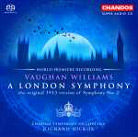September 2003
The original version of the piece is 20 minutes longer than the 1933 revision and it is full of gorgeous, melodic passages. Most of these are of a mystical, mysterious, and ruminative nature, such as the extended section that occurs in the fourth movement. Many friends and fellow composers seem to have regretted the excision of this music, but the composer justifiably felt that tightening the piece made its structure clearer and stronger. The thorough notes present many quotes and give a detailed history of the composition throughout its 20 years of revision. It is fitting that a tone poem by George Butterworth fills out this CD. Butterworth was the composer who suggested to Vaughan Williams that he write a symphony. Butterworth was killed while serving in the First World War, whereupon Vaughan Williams appropriately dedicated the symphony to him. The Banks of Green Willow is one of Butterworth’s most effervescent, shimmering tone poems. This brief piece seems the epitome of the English countryside. Richard Hickox has become one of England’s leading conductors, more or less filling in the gap created by the death of Sir Adrian Boult in 1983. His readings are similar -- genial, and bright, exciting but seldom hard driven. He elicits virtuoso playing from his musicians, and full orchestral statements are always unanimous. His reading of A London Symphony captures all the thrill of a bustling city at work and play, not neglecting the more muted, lyrical sounds of the nearby countryside or a moonlit night. So far, Chandos multichannel SACD sound has been an example of admirable discretion, and this recording is no different. A London Symphony begins with double basses and cellos stage right and rear, then woodwinds center and midstage. The center channel anchors all the instruments in place and these elements all sound very natural, with admirable stage width and depth, with little attention being called to the rear channels. These channels come into play primarily when the full orchestra is playing, especially when underpinned by percussion, just as it would sound in a real hall. The stereo tracks are appealing but not as rich and three-dimensional as the multichannel ones. It seems that Chandos will be releasing the entire Hickox cycle on SACD. Symphonies 3, 4, and 5 are already out. They are played as well as this one, and sound equally good. This is a series well worth collecting. GO BACK TO: |
 Vaughn Williams - A
London Symphony (Symphony No.2)
Vaughn Williams - A
London Symphony (Symphony No.2) Ralph Vaughan Williams’ loving, colorful orchestral portrait
of London was finished in 1913 and first performed in 1914. According to the fascinating
notes contained with this Chandos recording, the full score was lost in Germany in 1914.
Vaughan Williams, conductor Geoffrey Toye, and E. J. Dent reconstructed the score for a
performance in 1915. The composer made further revisions in 1918, 1920, and 1933. It is
the latter version that has been played and recorded many times, and over the years it has
become an audiophile favorite. This CD presents the world premiere recording of the 1913
original.
Ralph Vaughan Williams’ loving, colorful orchestral portrait
of London was finished in 1913 and first performed in 1914. According to the fascinating
notes contained with this Chandos recording, the full score was lost in Germany in 1914.
Vaughan Williams, conductor Geoffrey Toye, and E. J. Dent reconstructed the score for a
performance in 1915. The composer made further revisions in 1918, 1920, and 1933. It is
the latter version that has been played and recorded many times, and over the years it has
become an audiophile favorite. This CD presents the world premiere recording of the 1913
original.